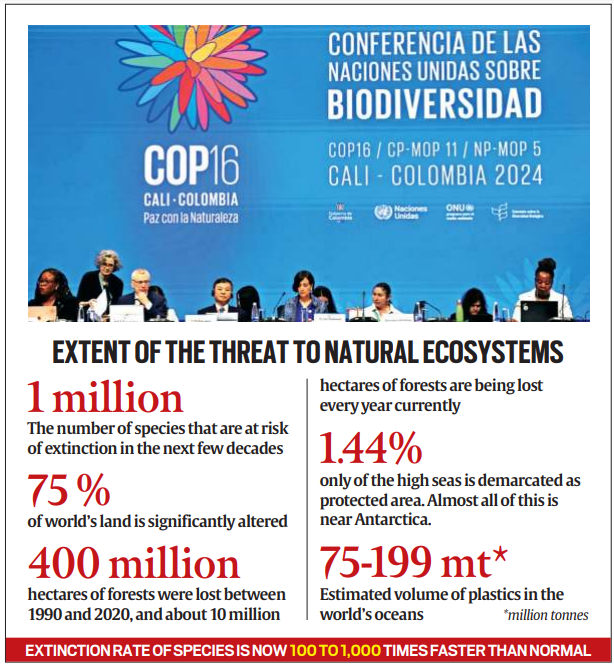UN Biodiversity Conference (COP16) Focuses on 30×30 Conservation Targets, Equitable Sharing of Genetic Resources, and Mobilizing $200 Billion for Global Biodiversity
(Source: Indian Express; Section: Explained; Page: 17)
| Topic: GS3 – Environment |
| Context: |
|
Analysis of News:

UN Biodiversity Conference and the Convention on Biological Diversity (CBD)
- Countries are currently meeting in Cali, Colombia, for the UN Biodiversity Conference, preceding the annual climate change summit in Baku, Azerbaijan.
- The CBD, established in 1992, aims to safeguard global biodiversity, restore ecosystems, and ensure equitable distribution of benefits from biological resources.
- This year’s COP16 meeting is significant as it follows the landmark Kunming-Montreal Global Biodiversity Framework finalized in 2022, which set out goals and targets for 2030.
What is the Kunming-Montreal Global Biodiversity Framework (KMGBF)?
- About: It is a multilateral treaty aimed at halting and reversing biodiversity loss globally by 2030.
-
- It was adopted in December 2022 during the 15th meeting of the Conference of the Parties (CoP).
-
- It supports the Sustainable Development Goals (SDGs) and builds upon the achievements and lessons learned from the Strategic Plan for Biodiversity 2011–2020.
- Purpose and Goals: It ensures that by 2030 at least 30% of areas of degraded terrestrial, inland water, and marine and coastal ecosystems are under effective restoration.
-
- It has 23 action-oriented global targets for urgent action over the decade to 2030 which will enable achievement towards the outcome-oriented goals for 2050.
-
- It is important to note that this target refers to collective global efforts rather than a requirement for each country to allocate 30% of its land and water areas.
- Long-Term Vision: The framework envisions that by 2050, there will be a collective commitment to living in harmony with nature, serving as a foundational guide for current actions and policies on biodiversity conservation and sustainable use.
30×30 Target and National Biodiversity Action Plans
- A key focus of COP16 is the 30×30 target, which aims to place 30% of the world’s lands and oceans under conservation by 2030 and restore 30% of degraded ecosystems.
- Countries are required to submit National Biodiversity Strategies and Action Plans (NBSAPs), similar to the climate change NDCs.
- As of now, only 32 countries have submitted their plans, with more expected to do so during the conference.
The High Seas Treaty and Genetic Resources
- The High Seas Treaty, concluded last year, was a major step in biodiversity conservation, aiming to protect marine biodiversity and regulate human activities in international waters.
- It also addresses the equitable sharing of benefits from genetic resources found in oceans, which is a major discussion point at COP16.
- The treaty seeks to ensure that profits from genetic sequences used for medical, commercial, or scientific purposes are shared equitably, especially with indigenous populations.
Financing for Biodiversity Conservation
- Finance remains a central issue at COP16, with a goal of mobilizing at least $200 billion annually by 2030 for biodiversity conservation.
- Developed countries are expected to contribute $20-30 billion yearly to support developing nations’ biodiversity efforts.
- Discussions also focus on phasing out harmful subsidies and incentives that damage biodiversity, such as those promoting deforestation or overfishing, with a target of redirecting $500 billion by 2030.
Potential New Financial Mechanisms
- Countries at COP16 are also exploring new financial mechanisms, including the possibility of setting up a dedicated biodiversity fund, biodiversity credits, and other innovative financing approaches, similar to carbon credits.
- These measures are essential for scaling up global biodiversity efforts and ensuring sustained financial support for conservation initiatives.
| How India Can Achieve the New Biodiversity Goals? |
|
| PYQ: With reference to ‘Global Environment Facility’, which of the following statements is/are correct?
(a) It serves as financial mechanism for ‘Convention on Biological Diversity’ and ‘United Nations Framework Convention on Climate Change’ (b) It undertakes scientific research on environmental issues at global level (c) It is an agency under OECD to facilitate the transfer of technology and funds to underdeveloped countries with specific aim to protect their environment (d) Both (a) and (b) Ans: (a) |
| Practice Question: The 16th Conference of Parties to the Convention on Biological Diversity (COP16) emphasizes the urgency of conserving biodiversity through the 30×30 target and equitable sharing of genetic resources. Discuss the significance of these goals and evaluate the challenges in mobilizing financial resources for global biodiversity conservation. (250 words/15 m) |
